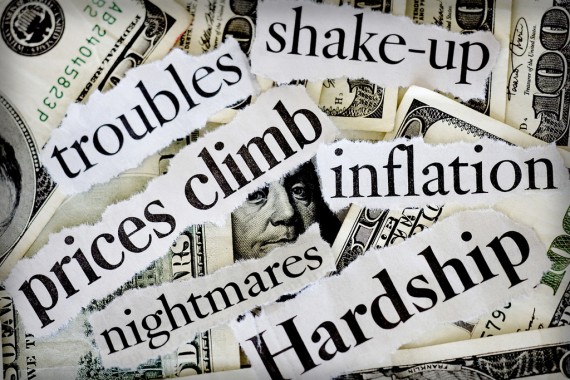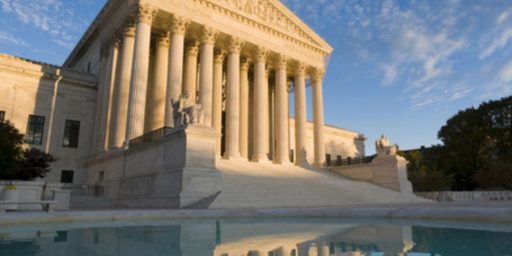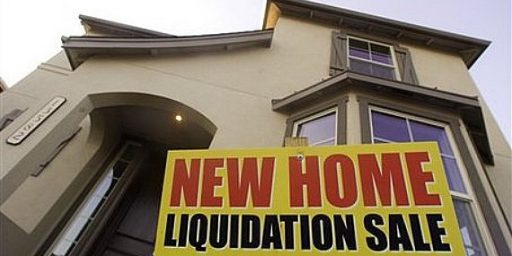What Caused the Financial Crisis?
Barry Ritholtz lists a dozen causes of the financial crisis.
Barry Ritholtz says Wall Street has been using the Big Lie theory to make people believe that the financial crisis was “caused by misguided government policies” rather than “irresponsible lending or derivative or excess leverage or misguided compensation packages.” Given how little traction that’s getting, I don’t find it particularly interesting.
His very long and yet concise list of the factors which did lead to the crisis, on the other hand, is quite useful in that it does a better job than anything I’ve seen elsewhere of capturing the complexity:
- Fed Chair Alan Greenspan dropped rates to 1 percent — levels not seen for half a century — and kept them there for an unprecedentedly long period. This caused a spiral in anything priced in dollars (i.e., oil, gold) or credit (i.e., housing) or liquidity driven (i.e., stocks).
- Low rates meant asset managers could no longer get decent yields from municipal bonds or Treasurys. Instead, they turned to high-yield mortgage-backed securities. Nearly all of them failed to do adequate due diligence before buying them, did not understand these instruments or the risk involved. They violated one of the most important rules of investing: Know what you own.
- Fund managers made this error because they relied on the credit ratings agencies — Moody’s, S&P and Fitch. They had placed an AAA rating on these junk securities, claiming they were as safe as U.S. Treasurys.
- Derivatives had become a uniquely unregulated financial instrument. They are exempt from all oversight, counter-party disclosure, exchange listing requirements, state insurance supervision and, most important, reserve requirements. This allowed AIG to write $3 trillion in derivatives while reserving precisely zero dollars against future claims.
- The Securities and Exchange Commission changed the leverage rules for just five Wall Street banks in 2004. The “Bear Stearns exemption” replaced the 1977 net capitalization rule’s 12-to-1 leverage limit. In its place, it allowed unlimited leverage for Goldman Sachs, Morgan Stanley, Merrill Lynch, Lehman Brothers and Bear Stearns. These banks ramped leverage to 20-, 30-, even 40-to-1. Extreme leverage leaves very little room for error.
- Wall Street’s compensation system was skewed toward short-term performance. It gives traders lots of upside and none of the downside. This creates incentives to take excessive risks.
- The demand for higher-yielding paper led Wall Street to begin bundling mortgages. The highest yielding were subprime mortgages. This market was dominated by non-bank originators exempt from most regulations. The Fed could have supervised them, but Greenspan did not.
- These mortgage originators’ lend-to-sell-to-securitizers model had them holding mortgages for a very short period. This allowed them to get creative with underwriting standards, abdicating traditional lending metrics such as income, credit rating, debt-service history and loan-to-value.
- “Innovative” mortgage products were developed to reach more subprime borrowers. These include 2/28 adjustable-rate mortgages, interest-only loans, piggy-bank mortgages (simultaneous underlying mortgage and home-equity lines) and the notorious negative amortization loans (borrower’s indebtedness goes up each month). These mortgages defaulted in vastly disproportionate numbers to traditional 30-year fixed mortgages.
- To keep up with these newfangled originators, traditional banks developed automated underwriting systems. The software was gamed by employees paid on loan volume, not quality.
- Glass-Steagall legislation, which kept Wall Street and Main Street banks walled off from each other, was repealed in 1998. This allowed FDIC-insured banks, whose deposits were guaranteed by the government, to engage in highly risky business. It also allowed the banks to bulk up, becoming bigger, more complex and unwieldy.
- Many states had anti-predatory lending laws on their books (along with lower defaults and foreclosure rates). In 2004, the Office of the Comptroller of the Currency federally preempted state laws regulating mortgage credit and national banks. Following this change, national lenders sold increasingly risky loan products in those states. Shortly after, their default and foreclosure rates skyrocketed. [odd admixture of bullets and numbering in original]
That’s an even dozen.







His list can be distilled to four words: Too much private debt.
Perhaps it is not a Big Lie, but it is a persistent and pervasive lie.
I think both the big banks and the government are culpable in this: the banks for not knowing what the heck they were doing and giving out loans to people who genuinely could not repay them, and the government for its easy money policies and bailing out the banks when they failed. If we had just let them go bankrupt, we could have washed the toxic debt out of the system. Yes, it would been painful, but that’s life, and our current efforts to desperately avoid pain have gotten us to where, exactly? Probably would have been shorter, too.
@Jeremy: Simply letting the banks go out of business wasn’t an option: they controlled far too much of the global financial infrastructure to go down without dragging us into a depression.
The best option was to:
1) Take them into receivership
2) Fire senior management
3) Wind down their debts
4) Chop them into little pieces
5) Sell the pieces back to the private sector.
No moral hazard, no being on the hook for banker stupidity.
@Jeremy:
My grandfather lost his life savings when his bank failed in the Great Depression. Even if we’d kept the FDIC bargain and let everything else go, brokerage accounts and retirement accounts would have been beyond-decimated.
No. Given that heroic measures were needed, the only rational follow-through was regulation and oversight to make sure it didn’t happen again. That is where we lost it. We did the bailouts (they continue with Fed policies) and then we pressed “New Game”
@Ben Wolf:
6) Shoot the bastards who invented credit default swaps pour encourager les autres.
Or is that too harsh?
So the financial crisis wasn’t caused by Rosa the cleaning lady who bought a house out in Riverside that she couldn’t afford?
I’ll be darned.
One thing came out of all this: Greenspan was disabused of that Randian bullshit he’d treated as revealed truth for most of his adult life.
@sam:
I believe he’s past that crisis of faith.
And that is sad commentary on faith, economics, and politics.
That dozen does a good job of explaining why a deflating bubble led to disaster, but it does very little to explain why the bubble was inflated at all. To raise the prices of homes, consumers had to be encouraged and implored to keep buying.
The Community Reinvestment Act had been around since 1977 — predating the bubble by decades — so it isn’t a very likely cause. It’s a favorite Republican talking point, since it helped poor and brown people, but no one can explain why it suddenly became a problem after two decades.
George W. Bush was promoting home ownership as the main goal of his “ownership society” throughout the 2000s, just acting like a salesman for the real estate industry. People keep forgetting that.
Actually, I don’t think it was Bush directly, but he’s a more likely cause than the CRA.
@Gustopher:
I think number 7 above is the key turning point. It was when Wall St. began making MBS, and before long they needed to keep them coming, no matter the borrower quality.
This country is in trouble because it has rejected the teachings of the Bible. Our priorities have been spending on our own pleasures, heavy drug abuse, addiction to pornography, the total decline of the family, women and children being abused, greed in banking and business at the expense of the workers, corrupt politicians and sex scandals by the dozens, worship of athletes and sports (accompanied by million dollar salaries to hit or catch a ball), and the disregard for decency, morals, and respect in all phases of life (look at schools), the Bible has been taken out of our public schools and other areas of life. You can’t even have a Nativity scene at Christmas without some misguided individual complaining and creating a scene. This is the result of the moral relevance, situation ethics, I’m okay, your okay philosophies that swept this country in the ’60’s as a cure all for the nation’s ills. What needs to be done? This country needs to get back to the Bible: the book of Isaiah warns the people to repent and change their ways. Whether you are a Christian or not, you have to admit that this country is going down the sewer and needs to change. If you are not a Christian, I urge you to find a Bible believing church and talk to the people there. Time is short.
@Catfish: I love your sense of sarcasm.
This add the missing point to the post and shows how the government was a mmajor player in the crash.
Smoking-Gun Document Ties Policy To Housing Crisis
By PAUL SPERRY, FOR INVESTOR’S BUSINESS DAILY Posted 10/31/2011 08:05 AM ET
View Enlarged Image
President Obama says the Occupy Wall Street protests show a “broad-based frustration” among Americans with the financial sector, which continues to kick against regulatory reforms three years after the financial crisis.
“You’re seeing some of the same folks who acted irresponsibly trying to fight efforts to crack down on the abusive practices that got us into this in the first place,” he complained earlier this month.
But what if government encouraged, even invented, those “abusive practices”?
Rewind to 1994. That year, the federal government declared war on an enemy — the racist lender — who officials claimed was to blame for differences in homeownership rate, and launched what would prove the costliest social crusade in U.S. history.
At President Clinton’s direction, no fewer than 10 federal agencies issued a chilling ultimatum to banks and mortgage lenders to ease credit for lower-income minorities or face investigations for lending discrimination and suffer the related adverse publicity. They also were threatened with denial of access to the all-important secondary mortgage market and stiff fines, along with other penalties.
Bubble? Regulators Blew It
The threat was codified in a 20-page “Policy Statement on Discrimination in Lending” and entered into the Federal Register on April 15, 1994, by the Interagency Task Force on Fair Lending. Clinton set up the little-known body to coordinate an unprecedented crackdown on alleged bank redlining.
The edict — completely overlooked by the Financial Crisis Inquiry Commission and the mainstream media — was signed by then-HUD Secretary Henry Cisneros, Attorney General Janet Reno, Comptroller of the Currency Eugene Ludwig and Federal Reserve Chairman Alan Greenspan, along with the heads of six other financial regulatory agencies.
“The agencies will not tolerate lending discrimination in any form,” the document warned financial institutions.
Ludwig at the time stated the ruling would be used by the agen cies as a fair-lending enforcement “tool,” and would apply to “all lenders” — including banks and thrifts, credit unions, mortgage brokers and finance companies.
The unusual full-court press was predicated on a Boston Fed study showing mortgage lenders rejecting blacks and Hispanics in greater proportion than whites. The author of the 1992 study, hired by the Clinton White House, claimed it was racial “discrimination.” But it was simply good underwriting.
It took private analysts, as well as at least one FDIC economist, little time to determine the Boston Fed study was terminally flawed. In addition to finding embarrassing mistakes in the data, they concluded that more relevant measures of a borrower’s credit history — such as past delinquencies and whether the borrower met lenders credit standards — explained the gap in lending between whites and blacks, who on average had poorer credit and higher defaults.
The study did not take into account a host of other relevant data factoring into denials, including applicants’ net worth, debt burden and employment record. Other variables, such as the size of down payments and the amount of the loans sought to the value of the property being bought, also were left out of the analysis. It also failed to consider whether the borrower submitted information that could not be verified, the presence of a cosigner and even the loan amount.
When these missing data were factored in, it became clear that the rejection rates were based on legitimate business decisions, not racism.
Still, the study was used to support a wholesale abandonment of traditional underwriting standards — the root cause of the mortgage crisis.
For the first time, Washington’s bank regulators put racial lending at the top of their checklist. Banks that failed to throw open their lending windows to credit-poor minorities were denied expansion plans by the Fed in an era of frenzied financial mergers and acquisitions. HUD threatened to deny them access to Fannie Mae and Freddie Mac, which it controlled. And the Justice Department sued them for lending discrimination and branded them as racists in the press.
“HUD is authorized to direct Fannie Mae and Freddie Mac to undertake various remedial actions, including suspension, probation, reprimand or settlement, against lenders found to have engaged in discriminatory lending practices,” the official policy statement warned.
The regulatory missive, which had the effect of law, advised lenders to bend “customary” underwriting standards for minority homebuyers with poor credit.
“Applying different lending standards to applicants who are members of a protected class is permissible,” it said. “In addition, providing different treatment to applicants to address past discrimination would be permissible.”
To that end, lenders were directed to “make changes in marketing strategy or loan products to better serve minority segments of the market.” They were also advised to “change commission structures” to encourage brokers and loan officers to “lend in minority and low-income neighborhoods” — a practice Countrywide Financial, the poster boy of the subprime scandal, perfected. The government now condemns the practice it once encouraged as “predatory.”
FDIC warned banks that even unintentional discrimination was against the law, and that they should be proactive in making “multicultural” loans. “An ounce of prevention is worth a pound of cure,” the agency said in a separate advisory.
Confronted with the combined force of 10 federal regulators, lenders naturally toed the line, and were soon aggressively marketing subprime mortgages in urban areas. The marching orders threw such a scare into the industry that the American Bankers Association issued a “fair-lending tool kit” to every member. The Mortgage Bankers Association of America signed a “fair-lending” contract with HUD. So did Countrywide.
HUD also pushed Fannie and Freddie, which in effect set industry underwriting standards, to buy subprime mortgages, freeing lenders to originate even more high-risk loans.
“Lenders should ensure that their loan processors and underwriters are aware of the provisions of the secondary market guidelines that provide various alternative and flexible means by which applicants may demonstrate their ability and willingness to repay their loans,” the policy statement decreed.
“Fannie Mae and Freddie Mac not infrequently purchase mortgages exceeding the suggested ratios” of monthly housing expense to income (28%) and total obligations to income (36%). (these are among the terms that define a conforming mortgage)
It warned lenders who rejected minority applicants with high debt ratios and low credit scores to “be prepared” to prove to federal regulators and prosecutors they weren’t racist. “The Department of Justice is authorized to use the full range of its enforcement authority.”
It took a little more than a decade for the negative effects of the assault on prudent lending to be felt. By 2006, the shaky subprime mortgages began to default. In 2008, the bubble exploded.
Clinton’s task force survived the Bush administration, during which it produced fair-lending brochures in Spanish for immigrant home-loan applicants.
And it’s still alive today. Obama is building on the fair-lending infrastructure Clinton put in place.
As IBD first reported in July, Attorney General Eric Holder has launched a witch hunt vs. “racist” banks.
“It’s a more aggressive fair-lending enforcement approach now,” said Washington lawyer Andrew Sandler of Buckley Sandler LLP in a recent interview. “It is well beyond anything we saw during the Clinton administration.”
Tom Perez, assistant attorney general for civil rights, recently testified that his division “continues to participate in the federal Interagency Fair Lending Task Force.” And he and the task force are working with the newly created Consumer Financial Protection Bureau to “enhance fair-lending enforcement.”
The fair-lending task force’s original policy paper undercuts the notion the financial crisis was all about banker “greed,” though it certainly played a role after the fact. Rather, it offers compelling evidence that the crisis evolved chiefly from government mandates and threats to increase lending to applicants who could not afford them.
http://news.investors.com/Article.aspx?id=589858&p=3
…..
Message 27 of 27 (20 Views)
.
Add Tag…
….
.
.
@Bob:
Huh, so now it really was the minorities who did. Who would of thunk it. And it all started in 1984. Producing a crisis 25 years later. Makes perfect sense to me.
Glad to know that if the banks could have kept on keeping blacks and hispanics in rentals, there would have been no crisis.
@Bob:
We’ve heard that claim before. That is what Barry crushes, above. Copy-and-paste does not really defeat a better understanding of history.
And certainly, if the only loans to go bad were the ones to red-lined minority borrowers, this would have been a much, much, smaller crash. It would not have affected multi-million dollar homes, as it did.
@Bob:
Can you produce any evidence that the nasty old government forced banks to make bad loans? Rumors don’t count. Show us a single loan where this happened. Show us the Wall Street Journal articles where the banks were complaining that they hated writing these bad loans, that they knew they would ruin their business, but that they had no choice. Oh, and that AIG was forced to rate the bonds AAAA even though they knew they were junk loans made to shiftless home-stealing thieves.
You can’t.
Funny how you all can read an article and not understand it. The government is always an enabler to crony corporatism. Banks could not do bad things without the governments enabling involvement.
In my view, the following all bare significant responsibility, ranked more or less as I see their culpability
Political elites
Government, regulators, oversight, and non political entities
FED
Banks
Fanny and Freddy
Individuals that signed loan documents they should not have
Credit rating agencies, Moody etc
Mortgage agitators such as ACORN
News media
Voters